Strategies to Improve Engagement in Underachieving Boys
| ✅ Paper Type: Free Essay | ✅ Subject: Teaching |
| ✅ Wordcount: 3653 words | ✅ Published: 23 Sep 2019 |
Introduction
The issue with boys and ‘underachievement’ is a topic that seems to reoccur every so often in education. Raising boys’ achievement is vital in aiding young individuals to be successful and has been emphasised throughout the country for some time. There is a real concern in boy’ progress and attainment by teachers and government education authorities. The data collected accentuates a reasonable concern over the boys’ achievement levels and success throughout their school life. (Younger et al, 2005) Underachievement is when a pupil is deemed to be skilled enough to reach that particular grade whether it is high or low, but does not reach that grade, for whatever reason.
“A strong ‘macho’ peer culture affects many boys’ attitudes towards schoolwork and homework” (Arnot et al., 1998, page 90). Where whole-class learning is taking place, pupils who underachieve contribute very little and underachieving boys hold back from positive class interactions very early on in their school life. There are many key aspects that play a role in influencing how students perform; the type of employment opportunities, the schools location, traditions within the community and religious backgrounds regarding employment for men and women and opinions of the importance of education are just several barriers some will have to learning.
There are numerous factors contributing to the underachievement of young boys. Bray (1997) state in their booklet ‘Can boys do better?’ the likely key factors affecting boys’ underachievement as a ‘complex web (including) genetic, social, attitudinal and contextual aspects.’ For some pupils, underachievement may cause them to think they are of a low-ability. Montgomery (1998, page 158) reviewing Cooper’s work (1984) states that, as an outcome, pupils’ self-esteem has faded and they lack motivation to work. This eventually leads to disruptive behavior within the classroom, which can later have harmful effects on all learners, those pupils who underachieve and those who don’t.
Many strategies already in use in schools for addressing boys’ underachievement have relied greatly on their learning styles. However, after analysing both student’ and teachers’ learning styles Coffield et al (2004) learned that girls and boys could not be specifically characterised by conventional learning styles of ‘kinesthetic’, ‘auditory’ and ‘visual’ and stated that the most successful ways to learn is by using a variety of all three leaning styles to allow for all students learning types to be targeted. Younger and Warrington (2005) also supports this when reviewing learning styles. After reading the works and ideas of some key researchers, it is evident that, in order for students to progress, there needs to be a combination of activities, mixing up the tasks each lesson to enable the students to be engaged and motivated to learn.
Establishing positive relationships within the classroom is vital for both student and teacher. Ensuring there is a positive leaning environment for all students is crucial in keeping students engaged with the teacher and their peers. A very powerful motivating tool is praise as this has the ability to improve behavior and classwork. It allows for the teacher to pin point particular students and encourage different qualities of student work. Studies have revealed the effects of teacher praise and interactions with students and established that “The power of praise in changing student behavior is that it both indicates teacher approval and informs the student about how the praised academic performance or behavior conforms to teacher expectations” (Burnett, 2001).
I have chosen to particularly focus on this class as they are the only year 8 class that I currently teach and I consider the boys to be underachieving compared to the girls. This was evident when marking the classes’ books and first assessment. I would like to see if my research and strategies would have a positive impact on the student’s progress and make a difference.
There will be many areas to explore in my enquiry however I will look at engaging approaches to help my year 8 boys in class 8L/EN2: What strategies can be implemented to improve engagement in underachieving boys in 8L/EN2? I would like to focus on exploring a variety of engaging/interactive activities and positive feedback and praise to help motivate the boys in that class.
In an article in the TES (23/08/18) Will Hazel states that on a national scale boys narrowed the gap at grade 4 and above and wrote ‘This year 62.3 per cent of male entries achieved this threshold, compared with 61.6 per cent last year’. So there was some improvement last year compared to the previous year.
Research Plan
Research question: What strategies can be implemented to improve engagement in underachieving boys in 8L/EN2?
This study will focus on and investigate the strategies that are the most effective in improving engagement in underachieving boys in my year 8 class. The research will enable me to understand some of the best strategies to engage students to help them make progress both in lessons and in their assessments. The theory is that the more engaging the activity is and the more variety there is, the more appealing the learning will be which will lead to progress. Some sub question’s that will arise from this investigation are:
- Will a variety of different activities help with their progress?
- Does competition help engage the boys in 8L/EN2?
My research will be mainly conducted by observing lessons with an available staff member from the English department and myself where we will observe and record how engaged the students are within the lessons, in particular focusing on various types starter activities and whether or not they have an impact on the rest of their learning. I will be focusing on four different activities for this study i.e. answering questions from the board, competitive group work, carousel activities and using mini white boards during tasks. I will be monitoring the students’ progress by looking at the amount of work completed in the lesson at the start and the end of the investigation to determine whether the students have improved. Wilson (2009) states that when conducted over a period of time, classroom observations are more reliable so having this in mind I will be observing the exact same students over a series of 10 lessons. In addition to the observations I will also be using a questionnaire to help me establish what activities the students feel they can engage with most. The survey-based questionnaires will allow the students to reflect on the lesson and what activities they liked and disliked and why and if including competition, does it make a difference to their progress. I believe that collecting data like this will enable them to feel that their views matter and make them feel important which will encourage motivation. It is also qualitative information, which is fundamental when collecting data like this. Using this data will furthermore allow the pupils to become independent learners when thinking and reflecting back on their learning and progress. It will also ensure that the teacher becomes ‘reflexive’ when they look back and reflect on their own practices in and out of the classroom. My methodologies will vary, as I will be analysing quantitative and qualitative data at the end of my enquiry.
Ethical considerations
In order for this investigation to be a success, it is very important to take into account ethical codes when carrying out this research, considering the purpose of the research and ensuring that I explain it fully to the students. I will explain the different strategies that will be used to help them make progress within the lessons and explain that it is important that they answer any proposed questions honestly. It is vital that the privacy of the student is adhered to and that all details will be confidential and not disclosed once the research is complete. In order to participate, the pupils will be giving their consent to take part in the project: this will be completed once the students have been informed about what will happen during the next few weeks. All participating students will be treated equally and should there be any ethical conflicts I will ensure I liaise with my mentor, PCM or university mentor.
The Findings
10 Class observations
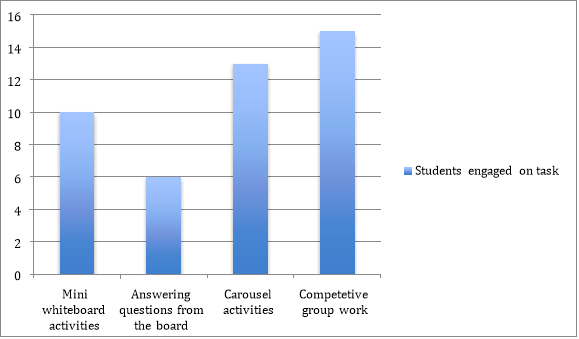
(Figure one)
Figure one above demonstrates the amount of pieces of work completed fully by the selected boys in my year 8 class over a period of 10 lessons. During the 10 lessons, I noted down the work the boys completed and which task they were mostly engaged with. I also asked other members of the English department to assist me if I was unable to collect the data myself (SPH, EGN). I created a tally record for each lesson and noted down the successful pieces of work, which demonstrates a sufficient amount of progress from the beginning of the lesson (see Appendix A). I included one strategy in each lesson and used it to see whether it produced an adequate amount of progress from the pupils.
It is evident from the outcomes above that the best results came from the competitive group work activities and were the most successful in getting the most work out of the students. The results coincide with the students’ questionnaires and Appendix E (evidence of their work). Whilst observing the class it was clear that the students found the group activities the most engaging and were keen to participate and produce the work within those lessons. There was rivalry and competition happening naturally within the groups as I would give student’s a role to play and each individual would prompt one another if they were not doing their role correctly.
I attempted some carousel activities where students worked in groups and moved around the classroom in they’re groups in a circular motion. The pupils would have three to five minutes at each station to discuss and add their own ideas and interpretations to the quote sheet provided or to write an additional part of the review that they were attempting to write as a class. This was an effective strategy at keeping the students focused and engaged with the work. All the students were enthusiastic, participated in the activity and successfully completed the tasks set. Even the lower ability students managed to complete the work as they found it easier working as a team. I also ensured that challenge activities were available for the higher achievers. Active, hands-on teaching strategies and learning activities are intended to make students active participants in their own learning. (Silberman, 1996: Buehl, 2001).
My observations found that answering questions from the board was the least successful of the strategies used and proved that it did not keep the students engaged enough to produce sufficient work. The questions needed to be answered in full sentences in their exercise books; however this was not the case as they would answer in note form or some in bullet points and some even missing questions out completely. It showed that students found this the least effective and engaging when completing the work and were easily distracted.
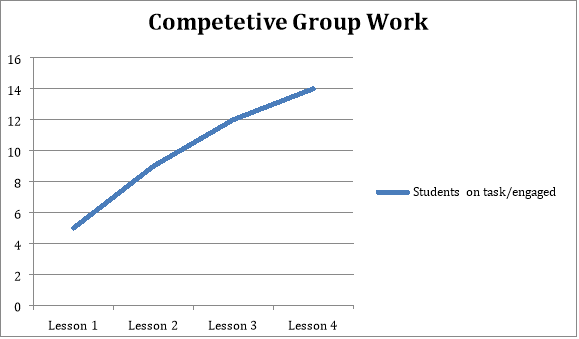 (Figure two)
(Figure two)
Over a period of four lessons I observed the students and I tallied the pupils who remain engaged from the start of the activity (Appendix B). Figure two above shows the data for the amount of students engaged during the competitive group work activity. I informed the students that there would be a reward for the group that produces the best answers to the questions provided. Out of the four lessons I used a ‘fill in the missing words’ activity in two of them; this was to ensure that there was a variety of activities to produce the same amount of work. The results indicate that some students at the beginning were not fully engaged and this was because of their preferred style of learning. Nevertheless, as time progressed the competitiveness between the students flourished and they all wanted to win the prize and be praised for good work.
All students were on task and engaged in the quiz and proved to be a successful strategy to keep the students focused and to produce a sufficient amount of work in the classroom. It can be seen that this type of activity also promotes a positive learning environment for the students to learn and absorb information effectively. Chen (2014) suggests, “ Competition is a powerful motivator for student behavior regularly applied in education research.” As seen in figure 2, a positive correlation is produced by the end of the observation. Reliable research has revealed that a positive school environment encourages and supports students’ academic achievements. Weimer (2009) implies that this type of environment “provides relevant content, clear learning goals and feedback, opportunities to build social skills, and strategies to help students succeed.”
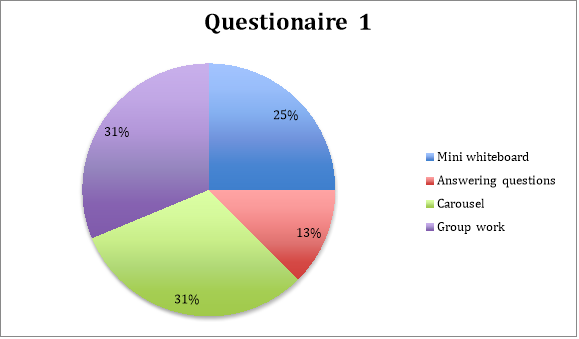 (Figure three)
(Figure three)
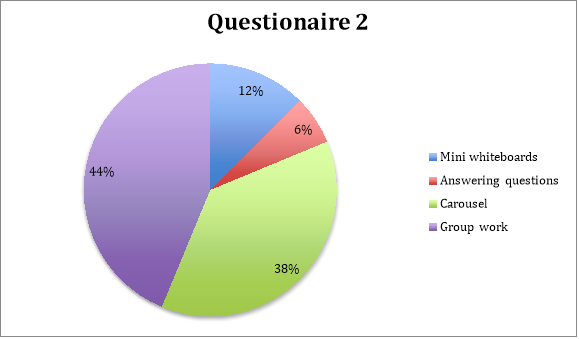 (Figure four)
(Figure four)
Above, figure three and four shows the student’s answers to the questionnaires. The first questionnaire (figure three) was given to the pupils in the first lesson the enquiry started; the students were questioned on which activity they think will aid them in making the most significant progress in lessons. I then gave them the same questionnaire again in the final lesson of the case study to identify whether their answers had altered since the first time they responded to it. As you can see 44% of the students think that group work helps them make the most progress during the lessons. This may be the case as they were given the opportunity to work with other students where they were able share and gather ideas relating to the tasks they were given each time they completed a group activity. The data also shows that carousel activities have had a significant impact on the students by the end of the investigation. 38% of students clearly feel that this strategy helps them make progress and upon reflecting back the students were really engaged when this activity was used. As the students gave personal responses and reflected on their progress during the lessons, this makes the data subjective.
Conclusion
What strategies can be implemented to improve engagement in underachieving boys in 8L/EN2?
- Will a variety of different activities help with their progress?
- Does competition help engage the boys in 8L/EN2?
The data shows that interactive activities can help students make some progress but it is questionable whether the progress is sufficient enough to improve their levels. It is apparent that there needs to be a variety of activities to improve engagement in underachieving boys and is clear from the research completed that competition definitely engages the boys as it helps to create a more stimulating, positive environment in the classroom. This encourages pupils to strive to become better learners and progress.
The data collected raises some discussion points that I will talk about in a little more detail. Competition was clearly an effective strategy to keep the boys engaged. All of the students wanted to win or be rewarded with a prize and the atmosphere in the classroom from this type of activity was proven to be extremely positive. It was prominent that the challenge to work together to produce the work required is stimulating for the boys. The use of competition against the girls in the class also influenced their motivation to succeed. Competition is considered as useful for student learning because it can reinforce the goal structure of learning activities (Davis & Rimm, 1985), which in turn, enhances students’ motivation and learning achievement (Ke, 2008a).
Group work involving competition has the utmost level of engagement in the classroom environment. Selecting a captain for each group and allowing the boys to play off against one another, worked well. The progress of work measured though was debatable but the students appeared to enjoy working collectively and against each other to get the work completed. This involves sharing their ideas with each other. The questionnaires that the students completed also coincide with this information. Younger (2004) says “the advantages to be gained through companionable writing with response partners and through group work are recongnised”. He clearly expresses that this is an effective strategy and group work will help raise boys’ attainment in the future.
Carousel activities have proven to be a positive and engaging activity to use in the classroom and I really do believe that they made progress using this strategy. This is because it is linked to kinesthetic learning and allows more freedom within the lessons where students are permitted to move around. The Ofsted document (2003, page 3/ 4) states clearly that “features of good teaching include “a sprightly pace” and that “boys often respond better to lessons that have clear structure and a variety of activities”. This supports the carousel strategy, as it is interactive and fast-pace learning. From the case study I can see that this style of activity did help the pupils make progress because they were fully engaged the whole time and not sat down in a seat for the hour.
The use of mini white boards in the classroom was somewhat successful particularly with the weaker students. Since beginning this enquiry the students that struggle with writing inevitably turn to the whiteboard to use during the lessons. It is clear that they found this extremely beneficial in helping them with the writing activities in particular.
The strategies that were used in this investigation will not rapidly fix underachievement at Southgate school. Nevertheless it can be seen as a tool to raise the students’ engagement in the lessons and help them make some progress. Ofsted report (2003, page 4) state that “Boys often respond better to lessons that have a clear structure and a variety of activities, including practical and activity-based learning, applications to real-life situations and an element of fun and competition. Many boys find it helpful to be given short-term targets and feedback that focuses on how they can improve”.
Completing this case study has made me more aware of some potential reasons why boys might be underachieving. Some have a poor attitude to learning, whereas poor behavior in class or lacking concentration skills plays a key factor for some of our students. These will contribute to their attainment levels and can be prevent them from reaching their overall target grades.
Ways forward
This enquiry has emphasised the importance of having a positive learning environment as it helps the pupils engage with the activities and their learning. “It is imperative that classroom teachers provide a positive learning environment. It is in the classroom that teachers have the greatest control over conditions that affect learning and behavior” (Stewart, Evans & Kaczynski, 1997, p. 53). Engaging tasks, particularly interactive ones are important to help encourage and inspire students to reach their full potential and these activities have positively had an impact on the students learning.
Looking back at the questionnaires and observations that I completed I think all teachers should think about using these activities within their lessons and varying activities to keep boys in particular stimulated. It is very clear that boys in particular find it challenging to concentrate and engage for a ling time and quickly disengage if not faced with an appealing task. A way forward would be to use the carousel activities because it allows the students freedom to move around the classroom rather than be static for the entire hour. Due to the active learning taking place within the lesson it will give the students the opportunity to be responsible for their own learning and ensures a sense of commitment from the boys to their learning.
In order to enhance and improve the investigation I would interview some of the students as another method to allow for a more in depth understanding about the students feelings towards learning in a classroom. I would ask they why they feel they perform better using some of the strategies. I would have liked to measure their progress using their data at the end of term if I had more time, as this would have enabled me to determine whether or not any interventions are needed to see whether that would have made a significant difference in their attainment. I would also have liked to see whether having a teaching assistant or a sixth form student present in the classroom for the students would have helped with their progress in the lessons.
Bibliography
- Buehl, D. 2001. Classroom Strategies for Interactive Learning, 2nd ed. Newark, DE: International Reading Association
- Bray, R., Gardener, C. and Parsons, N. (1997). Can Boys Do Better? Leicester: Secondary Heads Association.
- Burnett (2001) online resource – https://www.interventioncentral.org/behavioral-interventions/motivation/teacher-praise-efficient-tool-motivate-students
- Cano, Jamie. (2001). What is known about effective teaching. The Agricultural Education Magazine. 74 (3). 6-7.
- Chen, Z.-H. (2014). Facilitating Learning Preferences and Motivation of Different Ability Students for Social-Competition or Self-Competition. Educational Technology & Society, 17 (1), 283–293.
- Coffield F, Moseley D, Hall E & Eccleston K (2004): Should We Be Using Learning Styles? What Research Has to Say to Practice, Learning and Skills Research Centre, London
- Davis, G., & Rimm, S. (1985). Education of the gifted and talented. Englewood Cliffs, NJ: Prentice-Hall.
- Hazel, W (2018) TES online article – https://www.tes.com/news/boys-will-be-boys-wont-they-only-if-we-let-them-be
- Ke, F. (2008a). Computer games application within alternative classroom goal structures: Cognitive, metacognitive, and affective evaluation. Educational Technology Research and Development, 56(5), 539-556
- Montgomery, D., (1998) Reversing Lower Attainment, London: David Fulton Publishers Ltd
- Ofsted, (2003) Boys’ Underachievement in Secondary Schools, London: Ofsted Publications Centre
- Sileberman, M. (1996) Active Learning: 101 Strategies to Teach any Subject. Needham Heights, MA: Allyn & Bacon.
- Stewart, Susan C., Evans, William H. & Kaczynski, Dan J. (1997). Setting the stage for success: Assessing the instructional environment. Preventing School Failure. (41). 53-56.
- Weimer, M. (2009). Effective Teaching Strategies: Six Keys to Classroom Excellence. Faculty Focus-Higher Education Teaching Strategies from Magna Publications.
- Wilson, E. (2009) School – based Research: A Guide for Education Students. Sage.
- Younger M & Warrington M (2005): Raising Boys’ Achievement in Secondary Schools, Open University Press, Buckingham
Appendix A: Completed work tally
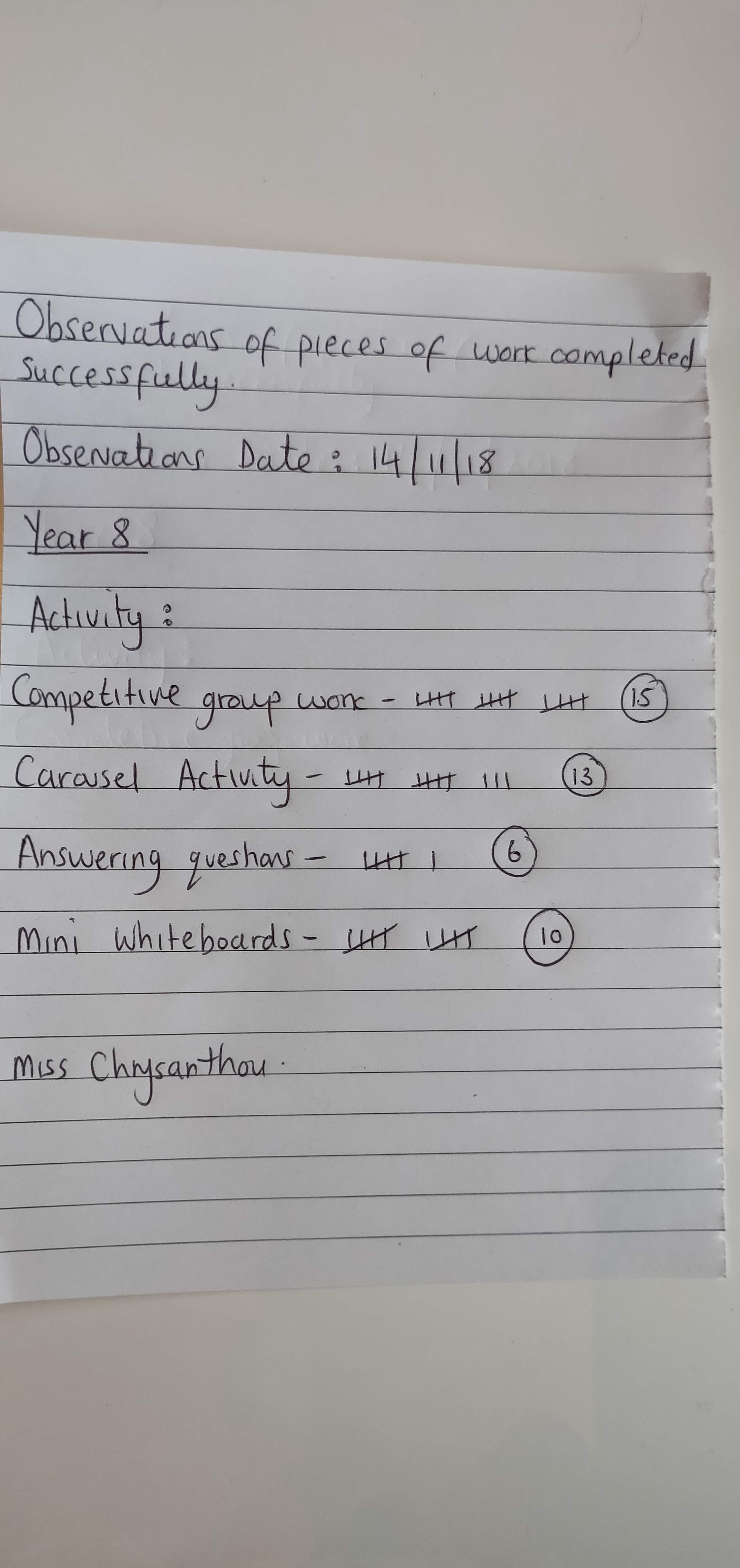
Appendix B – Students engagement tally
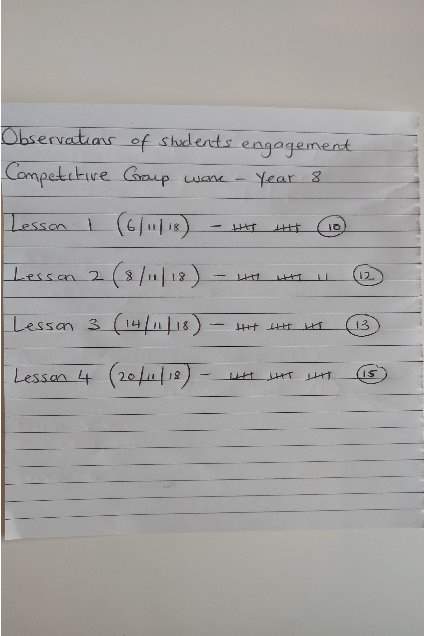
Appendix C – Student’s answers to questionnaire
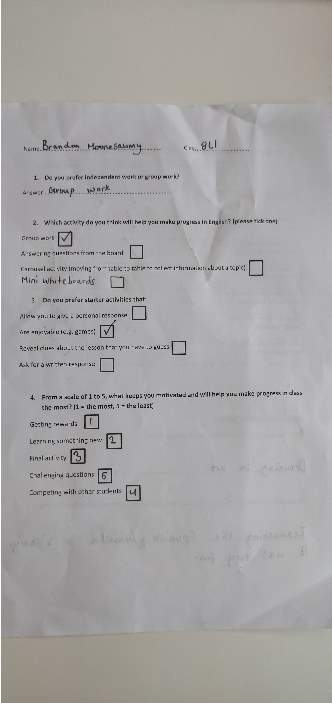
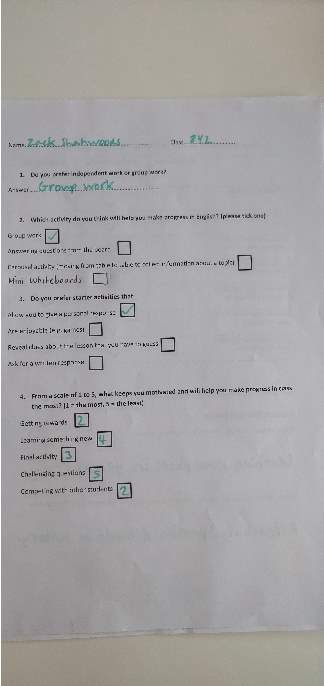
Appendix D – Example’s of a piece’s of work completed by students
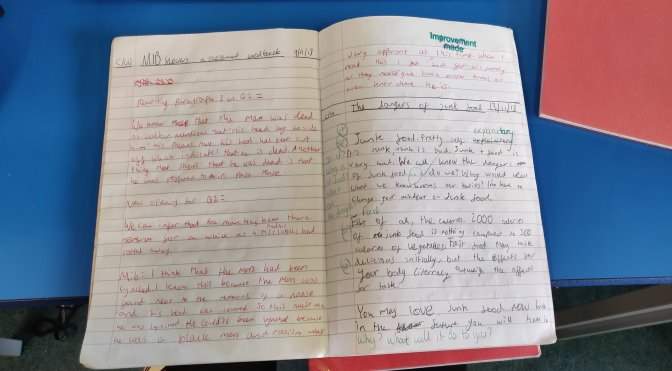
(Make it better lesson – completed in groups rather than independently)

(Carousel activity – each group giving a point to support their argument then passed around to the other groups to counter argue)
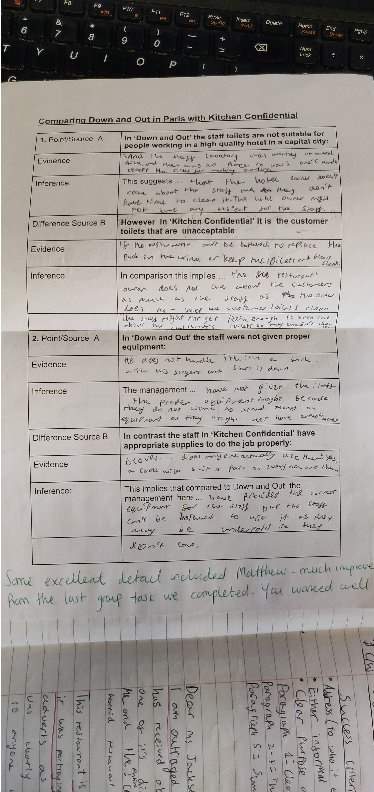
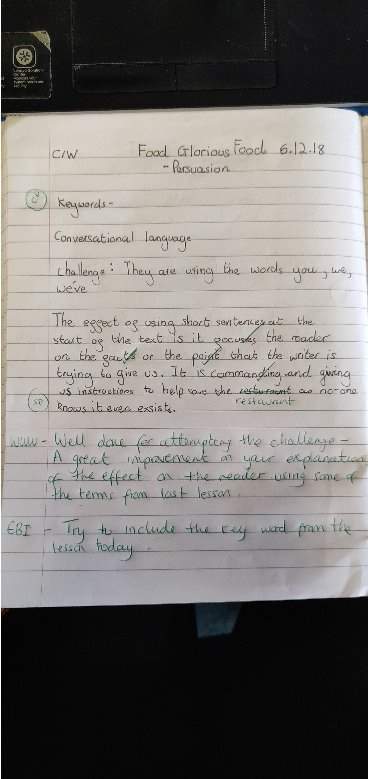
Cite This Work
To export a reference to this article please select a referencing stye below:
Related Services
View allDMCA / Removal Request
If you are the original writer of this essay and no longer wish to have your work published on UKEssays.com then please click the following link to email our support team:
Request essay removal


